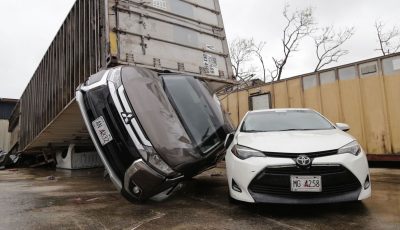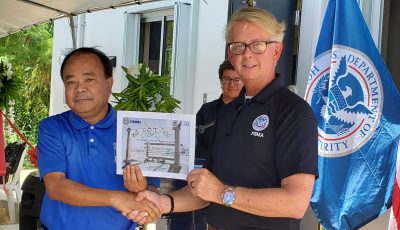Disaster relief mission showcases DoD preparedness and teamwork
In the 10 years since Hurricane Katrina struck—one of the most devastating natural disasters in U.S. history—the Defense Department and its partners have been working hard to use the knowledge and experience gained in that terrible event to help in other disaster-stricken areas.
The Defense Department, coordinating with the Federal Emergency Management Agency, recently completed its largest-ever relief mission after Typhoon Soudelor plowed through Saipan, the most populated island in the Northern Mariana Islands, Aug. 2-3 and left more than 50,000 people without electricity or water. In a joint effort, the DoD and its assets moved quickly to assist with disaster relief mission, ensuring the islanders in the region had water and food until they were self-sustaining.

Vehicles from the 31st Marine Expeditionary Unit are unloaded from the well deck of the amphibious dock landing ship USS Ashland (LSD 48) via Landing Craft Utility vehicle during disaster relief efforts on Saipan after Typhoon Soudelor made landfall. Ashland is assigned to the Bonhomme Richard Expeditionary Strike Group and is on patrol in the U.S. 7th Fleet area of operations. (U.S. NAVY/MC3 DAVID A. COX)
Navy Rear Adm. Babette “Bette” Bolivar, the defense coordinating officer for the disaster relief mission, discussed the joint effort, strengthening our relationship with the Northern Mariana Islands and what we can do to stay prepared for natural disasters.
During the mission, the Guam National Guard, Army, Air Force, Marines, Navy, Coast Guard and FEMA all worked with the Northern Mariana Islands government, showcasing their ability to work together and complement each other as a joint force.
“It brought to light the synergy between the services and the ability to have that teamwork to accomplish the mission,” Bolivar said.
Approximately 600 Marines and sailors assigned to the 31st Marine Expeditionary Unit and based aboard the USS Ashland delivered food and water, while also clearing debris from schools.
Airmen from the 36th Contingency Response Group stationed at Andersen Air Force Base in Guam assisted with unloading relief supplies at Saipan International Airport.
The Army Corps of Engineers and Coast Guard also contributed to cleanup and relief efforts, Bolivar said.
Bolivar also stressed the importance of being prepared, especially if you live in an area that is frequently in the path of hurricanes, tropical storms or other natural disasters.
“We foot-stomped the message to our families to ensure they have a home disaster preparedness kit. It may take the disaster response teams some time to get there so it’s important to have that kit,” she said. Kits should include items such as flashlights, water, and canned food, she said. More information about disaster preparation, including information specifically for military families, can be found at http://www.ready.gov.
With Typhoon Soudelor happening nearly 10 years after Katrina, Bolivar said the lessons learned from that event have a residual effect on how DoD now operates during a natural disaster.
“I remember that after Katrina there was a big push with military leaders to become well-versed in what the process was with FEMA,” she said. “I would say that since Katrina there is more awareness and more training. In terms of the coordination process, I believe the understanding of that helped us ensure that the partnership between the government of [the Northern Mariana Islands], FEMA and the DoD was spot-on.”
Bolivar said that while the typhoon itself was unfortunate, the relief efforts strengthened our relationship in the region and with the Northern Mariana Islanders.
“We already had a great relationship with Saipan. This event swayed the public and won the hearts and minds of the people of Saipan,” she said. “They were so grateful. When we had our teams out there, they would bring them food as a way of saying thanks. It was an unfortunate event but it strengthened our relationship with Saipan.”



























